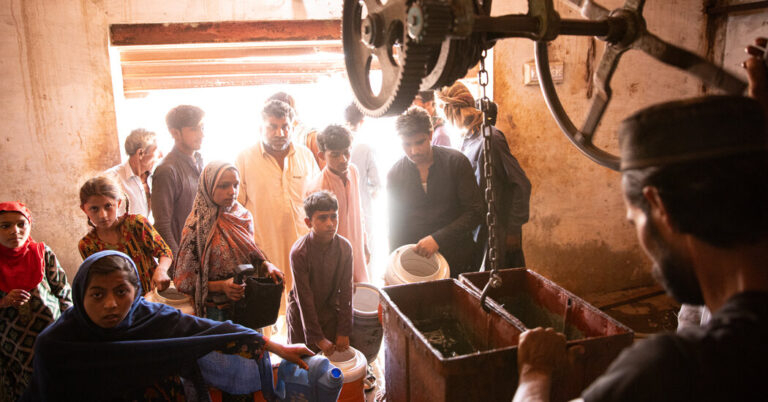As a heatwave grips South Asia, life-and-death decisions are made in the midday sun.
Abideen Khan and his 10-year-old son make $3.50 a day molding mud into bricks in an open-air kiln in the southern Pakistani city of Jacobabad, and they don’t want to waste a cent of it. But in recent days, temperatures have soared to 126 degrees Fahrenheit (52 degrees Celsius), forcing them to stop work by 1 p.m. and cutting their income in half.
“This isn’t the heat,” Khan said, sweat streaming down his face and soaking his old clothes. “This might be a punishment from God.”
It’s another brutal summer in the age of climate change, and the region is one of the most vulnerable to the devastating effects of climate change. And more suffering is on the way. Pakistan and neighboring India are experiencing extreme heat that forecasters predict will continue for the next few days and weeks. Already, it has claimed a life.
In the northern Indian state of Bihar, officials said at least 14 people had died from the heat, though reports from other northern Indian states suggest the death toll may be higher. Hospitals in both India and Pakistan are reporting large numbers of heatstroke patients.
Ten of the deaths in Bihar were polling officials preparing the state for voting on Saturday, the final day of India’s general election. To beat the heat, glucose and electrolytes are being distributed to polling officials, tents are being erected to provide shade and clay pots of cold water are being served. At least six election guards have died in Uttar Pradesh. New Delhi, where temperatures have approached 122 degrees this week, nearly 20 degrees above normal, recorded its first official heatstroke death this year on Wednesday.
In Jacobabad, long considered one of the hottest places on Earth, temperatures reached 126 degrees Fahrenheit on Sunday and 124 degrees each of the next three days. About 75 miles away, the Pakistani town of Mohenjo Daro, famous for the ruins of the Indus Valley Civilization dating back to 2500 B.C., reached 127 degrees Fahrenheit on Sunday, just shy of the highest temperature recorded in 2010.
The scorching temperatures compound the challenges for Pakistan, a country of 241 million people already struggling with economic and political turmoil.
For the more than one million people who live in Jacobabad district, life revolves around the constant struggle to find ways to cope with the heat. Power outages typically last between 12 and 20 hours a day, and some villages have no electricity at all. Lack of basic necessities like water and proper shelter exacerbates their suffering.
Most residents cannot afford alternatives like air conditioners, Chinese-made solar batteries and rechargeable fans. A solar panel to power two fans and a light bulb costs about a month’s wages for a Jacobabad worker.
The water crisis is so severe that donkeys can be seen carrying tanks on the streets, from which residents buy five small plastic jerrycans of water for $1. Surge in demand has driven up the price of ice, making the essential commodity even harder to come by.
Many of the poor have no choice but to work outdoors. Rice, the lifeblood of Pakistan’s agriculture, requires backbreaking labor in the fields during the hottest months of May, May, and July.
For Sahiba, a 25-year-old farm labourer who only gives one name, each day begins before dawn. She cooks for her family, walks miles with other women to the fields and works hard well into the afternoon under the relentless sun. Nine months pregnant with her 10th child, she carries a double burden.
“If we miss a day or half a day, we don’t get our daily wages and my children go hungry that evening,” Sahiba said.
Each summer, according to local activists, 25 to 30 percent of the district’s population becomes temporary climate refugees, fleeing to Quetta, a city 185 miles to the north where the heat is more tolerable. Others make their way to the port city of Karachi, 310 miles to the south, which also suffers from sweltering heat but has less frequent power outages, providing some relief.
“Those who can afford it can rent homes in cooler cities, but most of the residents are simply too poor and struggle to survive under makeshift tents set up in the open,” said Jean Odano, head of the Community Development Foundation, a Jacobabad-based group that helps the poor cope with the heat.
Jansher Khoso, a 38-year-old garment worker, knows this struggle all too well.
In 2018, his mother was hospitalized with heat stroke as temperatures soared in Jacobabad. Now, he sends his family to Quetta every April to stay there until autumn while he works in Karachi. But this comes at a high cost.
“I am working 16-hour days in Karachi to cover the costs of this temporary move,” Khoso said, “because I don’t want any of my family to die in the scorching heat in Jacobabad.”
Jacobabad’s suffering isn’t just limited to the heat: in 2022, monsoon rains and devastating floods caused by extreme weather events linked to climate change submerged about a third of the district and Pakistan, killing at least 1,700 people.
The heat is nothing new to the city, named after British Brigadier General John Jacob, who experienced the city’s harsh climate first-hand in the 19th century.
General Jacob, leading a small force to suppress rebellious tribes and bandits, lost one lieutenant and seven men to the heat on the first day of a ten-mile march. His diary noted that even at night the wind felt like “a gust from a furnace.”
To cope with the harsh climate, General Jacob installed an irrigation system and built three canals to provide residents with fresh river water. Today, the canals are dry and full of rubbish.
Suhasini Raj Contributed reporting from New Delhi.

